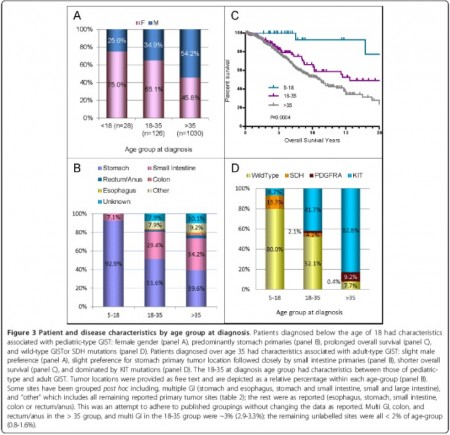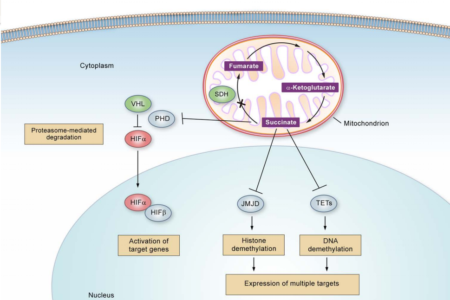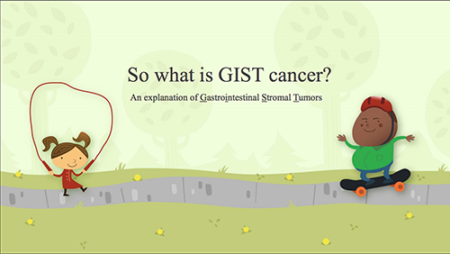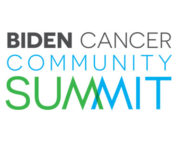Like adult GIST, pediatric GIST can be further divided into subgroups. The most familiar and perhaps the most common type does not seem to have a distinct name so let’s just call it “Pediatric GIST.” It most commonly affects girls between the ages of about 6 to 18 and almost always starts in the stomach.
The second well-known type of GIST affecting young people is called “Carney’s Triad.” It is named after Dr. J. Aidan Carney who first described it in 1977. Patients with Carney’s Triad may have several different types of tumors including GIST, pulmonary chondroma, and/or functioning extra-adrenal paraganglioma. If any two of these tumors are present, a diagnosis of the “triad” can be made, particularly if age and sex factors are supportive.
In 2002, Dr. Carney and Dr. Constantine Stratakis reported on a new syndrome that was similar to, yet distinct, from Carney’s triad. They had found 12 patients in 5 families with two parts of the “triad,” paraganglioma and GIST. Since this condition appeared to be inheritable and the “true Carney’s Triad” did not, Carney and Stratakis concluded that this syndrome was different than Carney’s Triad and called it “Familial Paraganglioma and Gastric Stromal Sarcoma” (also known as Carney-Stratakis Syndrome). The patients varied in age from 9 to 46 years old at diagnosis with 9 of the 14 patients under the age of 23.
When looking at multiple medical reports, it appears like there may be one more type of pediatric GIST. The youngest GIST patients of all may be born with GIST and need surgery soon after birth. This type of GIST, called “neonatal or congenital GIST”, appears to affect both boys and girls (although girls are more common) and seems to start in the intestines instead of the stomach. We found 6 cases described as GIST in newborns, however there seems to be some doubt about whether or not these are really leiomyosarcomas or GISTs.
Resources for children created by pediatric GIST survivor, Erin MacBean (see Erin’s story).
Join the Life Raft Group and the GIST Collaborative Tissue Bank
To join the Pediatric GIST and Carney’s Triad listserv, please visit GIST Support International
This pediatric portion of the website is dedicated to the memory of Jonathan Montague.
Articles on Pediatric GIST
New Study Aids in the Diagnosis of Hereditary Paraganglioma and Pheochromocytoma
A recent study in Cancer Genetics, International initiative for a curated SDHB variant database improving the diagnosis of hereditary paraganglioma and pheochromocytoma, is important for GIST patients who carry a germline SDHB mutation
NIH Pediatric & Wildtype GIST Clinic 2021 Applications Are Open!
The LRG will be collaborating with the NIH again in 2021 to hold the Virtual GIST Tumor Board in place of the NIH's Pediatric & Wildtype GIST Clinic normally held in the DC area. Applications to have cases reviewed are now open.
Pediatric & SDH-Deficient GIST Consortium Update
Setting the Pace for the Future In July of 2018 at Life Fest, The Life Raft Group brought together a team of pediatric & SDH-deficient GIST experts for a symposium focused on this rare [...]
The Life Raft Group Announces an Innovative Consortium to Accelerate Cancer Research at the Biden Cancer Summit
WAYNE, N.J. and WASHINGTON, D.C. (September 21, 2018) - The Life Raft Group announces at the Biden Cancer Summit a new initiative to strengthen and advance research for effective treatments of a rare subset of [...]
A New Lifeline – The Pediatric & SDH-Deficient GIST Consortium
The Life Raft Group is excited to cast a new lifeline to increase the quality of life and survival rates of Pediatric and SDH-Deficient GIST patients worldwide through the establishment of a collaborative research consortium. The Pediatric & SDH-Deficient GIST Consortium, unveiled today at the Biden Cancer Summit, supports patients and caregivers at a critical time to share data, tissue, and resources to address the urgency of cancer treatment.
Life Fest Pediatric/SDH Deficient GIST Track Provides Wealth of Information
The 2018 Life Fest Meeting was held in Miami on July 13 - 15 and was attended by 140 patients, friends, family and caregivers. This was a truly international event, with participation from 20 [...]







